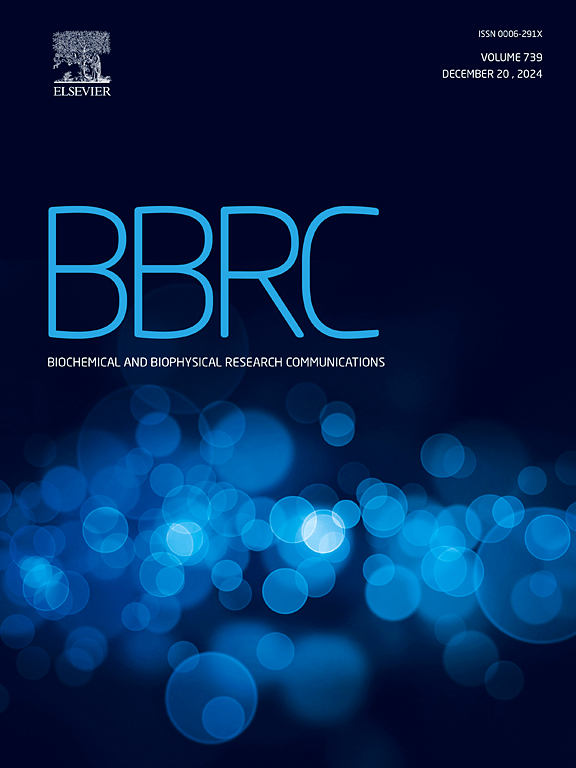Multi-omics investigation of the mechanism underlying castration-induced subcutaneous fat deposition in male mice
IF 2.5
3区 生物学
Q3 BIOCHEMISTRY & MOLECULAR BIOLOGY
Biochemical and biophysical research communications
Pub Date : 2025-06-19
DOI:10.1016/j.bbrc.2025.152233
引用次数: 0
Abstract
Obesity is a global epidemic that threatens public health. Castration promotes the deposition of subcutaneous fat. However, the underlying mechanism remains unclear. The gut microbiota and their associated metabolites may regulate castration-induced subcutaneous fat deposition. In this study, we found surgical castration significantly increased subcutaneous fat deposition, adipocyte size, and fatty acid abundance in mice. Castration affected the β diversity of cecal bacteria and changed the interaction between bacteria and fungi. Castration enhanced cecal glycerolipid metabolism, which was significantly positively correlated with clavispora, Galactomyces, Ligilactobacillus, Adlercreutzia, Anaerovorax, Christensenella, and the Prevotellaceae NK3B3l group. Castration enhanced the abundance of glycerol, sn-glycerol 3-phosphate, dihydroxyacetone phosphate, and lipoteichoic acid in the serum, which influenced the expression of Gpat4, Lpin1, Gpat3, Gpam, Akr1b10, Agpat1, and Akr1a1 in the subcutaneous fat. These genes were involved in glycerolipid metabolism and the regulation of lipid droplet formation. Furthermore, they showed a significant positive correlation with subcutaneous fat weight. Gene set enrichment analysis confirmed that castration enhanced lipid droplet storage and fatty acid synthesis in the subcutaneous fat. These results confirm that glycerolipid metabolism regulates subcutaneous fat deposition in mice after castration from the gut-serum-subcutaneous fat axis.

雄性小鼠去势诱导皮下脂肪沉积机制的多组学研究
肥胖是一种威胁公众健康的全球性流行病。阉割促进皮下脂肪的沉积。然而,其潜在机制尚不清楚。肠道微生物群及其相关代谢物可能调节阉割诱导的皮下脂肪沉积。在这项研究中,我们发现手术阉割显著增加了小鼠皮下脂肪沉积、脂肪细胞大小和脂肪酸丰度。去势影响了盲肠细菌β多样性,改变了细菌与真菌的相互作用。去势增强了盲肠甘油脂代谢,且与锁孢菌、半乳菌、乳酸菌、克氏Adlercreutzia、厌氧菌、Christensenella和Prevotellaceae NK3B3l组呈显著正相关。去势增加了血清中甘油、asn -甘油3-磷酸、磷酸二羟丙酮和脂磷胆酸的丰度,影响了皮下脂肪中Gpat4、Lpin1、Gpat3、gam、Akr1b10、Agpat1和Akr1a1的表达。这些基因参与了甘油脂代谢和脂滴形成的调控。此外,它们与皮下脂肪重量呈显著正相关。基因集富集分析证实,阉割增强了皮下脂肪的脂滴储存和脂肪酸合成。这些结果证实,甘油脂代谢从肠-血清-皮下脂肪轴调节阉割后小鼠皮下脂肪沉积。
本文章由计算机程序翻译,如有差异,请以英文原文为准。
求助全文
约1分钟内获得全文
求助全文
来源期刊
CiteScore
6.10
自引率
0.00%
发文量
1400
审稿时长
14 days
期刊介绍:
Biochemical and Biophysical Research Communications is the premier international journal devoted to the very rapid dissemination of timely and significant experimental results in diverse fields of biological research. The development of the "Breakthroughs and Views" section brings the minireview format to the journal, and issues often contain collections of special interest manuscripts. BBRC is published weekly (52 issues/year).Research Areas now include: Biochemistry; biophysics; cell biology; developmental biology; immunology
; molecular biology; neurobiology; plant biology and proteomics

 求助内容:
求助内容: 应助结果提醒方式:
应助结果提醒方式:


